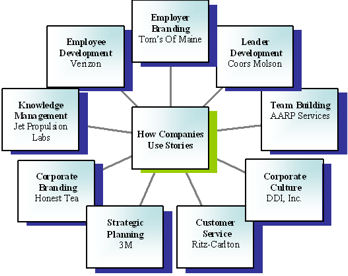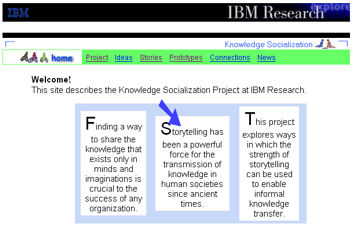Stories and storytelling cut across all types of industries and all business functions. The diagram below is only a narrow snapshot of where and how stories are used. You need a super wide angle lens to capture the corporate storytelling landscape. Note also that stories transcend organization size.
Stories are not limited to lofty corporate wide applications. I’ve seen more “mundane” uses such as a start-up using a story in its business plan presentation to investors, a six sigma consulting company using stories to help their clients and government vendors using stories in their proposal applications.
There have been a few articles on storytelling published in the Harvard Business Review and other publications. But it hasn’t yet hit the Business Top Ten List.
Stories constitute the single most powerful weapon in a leader’s arsenal.
Dr. Howard Gardner, Professor, Harvard University, Author of Leading Minds
Storytelling is a very serious business tool. Look at the best books in business – they all include stories or anecdotes about real business topics. Michael Hattersley, who in his Harvard Business Review article says,
Too often, we make the mistake of thinking of business as a matter of pure rational calculation, something that in a few years computers will handle better than humans. One hears this in conference room and corridor: “What do the numbers indicate?” “Just give me the facts.” “Let’s weigh the evidence and make the right decision.” And yet, truth to tell, few talents are more important to managerial success than knowing how to tell a good story.
I know from my own experience that stories work. You might think that a degree in business or better yet an MBA is needed to become a leader – wrong! I have both, but when I got my first supervisory job, I realized how little I knew about what it took to be a good leader. What I do remember from my Management Leadership course with Peter Drucker was his telling stories about how Alfred Sloan led General Motors to a transformation. He also told stories about his own development – when he was a young manager he learned how never to surprise your boss. Stories stay with you because they involve people and how they deal with real situations and issues.
How Companies Use Stories
Stories and storytelling cut across all types of industries and all business functions. The diagram below is only a narrow snapshot of where and how stories are used. You need a super wide angle lens to capture the corporate storytelling landscape. Note also that stories transcend organization size.
Stories are not limited to lofty corporate wide applications. I’ve seen more “mundane” uses such as a start-up using a story in its business plan presentation to investors, a six sigma consulting company using stories to help their clients and government vendors using stories in their proposal applications.
Here are some examples of how companies use stories.
- 3M company is currently using stories as part of its business planning to generate excitement and commitment. Their strategic stories set the stage, introduce dramatic conflict and outline the challenges the company is facing, and reach a resolution, which outlines the organization’s approach to the future.
- Physician Sales & Service (PSS) employees chuckle whenever their CEO tells a story about a bad bank relationship. And they learn, or relearn, an important lesson: No matter how badly other people treat you, no matter how confident you get about your future, never burn your bridges. The power of this story inside PSS also offers a lesson about leadership itself: In the new world of business, where it’s every executive’s job to make sense of a fast-changing environment, storytelling is the ultimate leadership tool.
- At Patagonia, an outdoor-sports apparel company in Ventura, California, customer storytellers surf at the “Point,” right outside the front door of headquarters. Founder Yvon Chouinard, who spends at least six months a year at the ends of the earth testing his company’s gear himself, has made a point of hiring several of these customers so they could share their war stories in-house. He refers to them affectionately as his “dirtbags,” people who spend so much time outside that it shows under their fingernails.
- Honest Tea in Bethesda, Md., is a purveyor of loose and bagged teas. It differentiates itself by exploring its roots at its web site. The “Our Story” section of the site describes how the company came up with the idea and started the business. “We know from our market research that people want to know more than just about a product, they want to know about the story of the company,” says co-founder Seth Goldman.
Want to learn more about using stories? Visit the Knowledge Socialization Project at IBM Research.
I like this site because it offers resources without any hard selling. More resources are available at clevelmanagers.com.
The primary element that links all storytelling applications is people. People are the most valuable asset in any organization. If you want to engage people, inspire and motivate them, you must capture their minds and hearts. Everybody knows about stories, they’ve heard them since they were very young. Good stories help to cut through jargon, corporate speak and allow people to link their own experience and emotional intelligence to the purpose of the story.
Steven Kerr, who ran GE’s Corporate University and now oversees Leadership Development at Goldman Sachs, posses an insightful question:
“Ask your company’s best leaders to name the most powerful learning experiences they’ve had. They will hardly ever mention a class and will most always name a real-life experience in business. The challenge is to find ways to replicate those experiences.”
I think that stories just might be the answer.
Ed Konczal has an MBA from New York University's Stern School of Business (with distinction). He has spent the last 10 years as an executive consultant focusing on human resources, leadership, market research, and business planning. Ed has over 10 years of top-level experience from AT&T in the areas of new ventures and business planning. He is co-author of the book "Simple Stories for Leadership Insight," published by University Press of America.



Ed, this is a brilliant article on storytelling. I am a member of Toastmaster’s and they encourage us all of them time to weave storytelling into our presentations. I am still perfecting it, but there is one member who has it down pat. He tells absolutely captivating stories that holds the audience’s attention and spell-binds us for the duration of his 8-10 minute speech. In business, people buy your product or service when they can “connect” with you. Through the use of effective story-telling, they do feel connected and are willing to entertain your ideas, then (hopefully) buy what you have. I think I’ll go work on my next speech and try to add in a killer story to wow my audience. Thanks Ed!